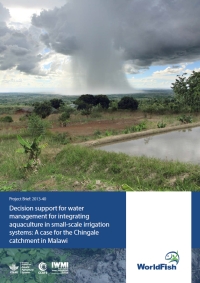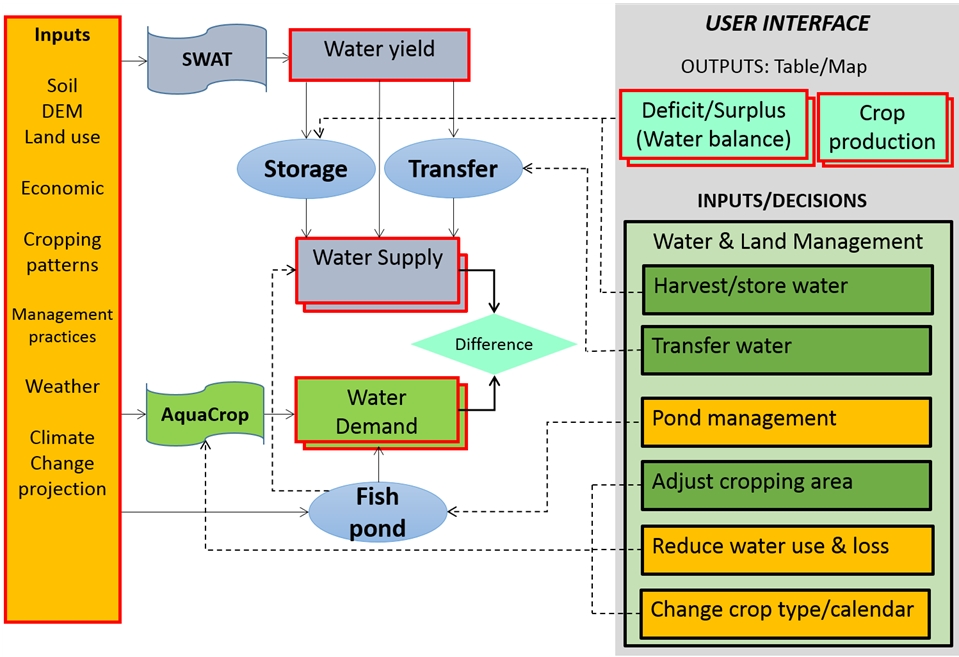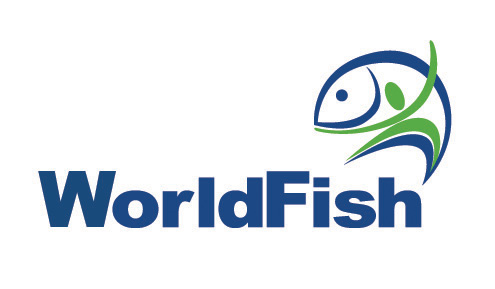Catchment Water Allocation Tool (or CaWAT) is a Microsoft® Excel-based computer decision support system for rural water resources management to support integrated irrigation and aquaculture development in small to medium watersheds. The tool allows for a number of interventions to be made in an interactive manner in the development, allocation and use of water resources to support rural livelihoods through the integration of agriculture, aquaculture and domestic uses.

The model was developed in response to the need for integrative tools to solve practical problems that people often face on the ground. Communities, local water managers and research for development practitioners often face the same questions: “How much water do we have?”, “Who is using this water?”, “How can we improve access to water with minimum costs?” and “What are the benefits to different users in the watershed?”. The real-world problem of local water resources development is often mixed involving engineering, agronomy, institutional and economic solutions. Also, the prerequisites to solving this problem are beyond the boundaries of science disciplines, and cannot be solved by individual models that are commonly available and focus on a specific part of the water, crop or economic component of the production cycle.
The tool integrates a hydrological model (Soil and Water Assessment Tool [SWAT] through an external connection) with a crop model (Food and Agriculture Organization of the United Nations [FAO] AquaCrop model plug-in inbuilt), a fish growth model, and a small storage management model to form a water resources management tool that will allow interactive and experimental water management practices and display the results. The management practices include water diversions, storage development, multi-purpose storage management, conversion of land use from one type to another, change of cropping patterns (crop type, area, growing season), water-saving irrigation and conservation farming practices. A schematic overview of the model component and the links to the user interface is shown below in Figure 1.

Note: DEM – Digital Elevation Model.
The model is intended to serve as a diagnosis tool to facilitate discussions and cooperation among neighbors, different water users and upstream/downstream stakeholders to make informed decisions for sustainable and equitable water resources development in small rural watersheds.
CaWAT was developed as part of the Enhancing adaptive capacity to climate change impacts through well-managed water use for aquaculture integrated with small-scale irrigation in the Chinyanja Triangle in Africa program, which covers Malawi, Mozambique and Zambia, and is funded by Bundesministerium für wirtschaftliche Zusammenarbeit und Entwicklung (BMZ) (Federal Ministry for Economic Cooperation and Development), Germany/Deutsche Gesellschaft für Internationale Zusammenarbeit (GIZ) GmbH. The model has been tested in Southern Malawi (Kam et al. 2013).
More information on the tool and the software package can be obtained from iwmi (at) cgiar.org.
Reference
Kam, S.P.; Cai, X.; Sood, A.; Hoanh, C.T.; Yen, B.T.; Nagoli, J.; Chijere, A. 2013. Decision support for water management for integrating aquaculture in small-scale irrigation systems: A case for the Chingale catchment in southern region of Malawi. Project report of the Enhancing Adaptive Capacity to Climate Change Impacts through Well-managed Water Use for Aquaculture Integrated with Small-scale Irrigation in the Chinyanja Triangle in Africa. Penang, Malaysia: WorldFish Center. 12p. (WorldFish Project Brief: 2013-40).




